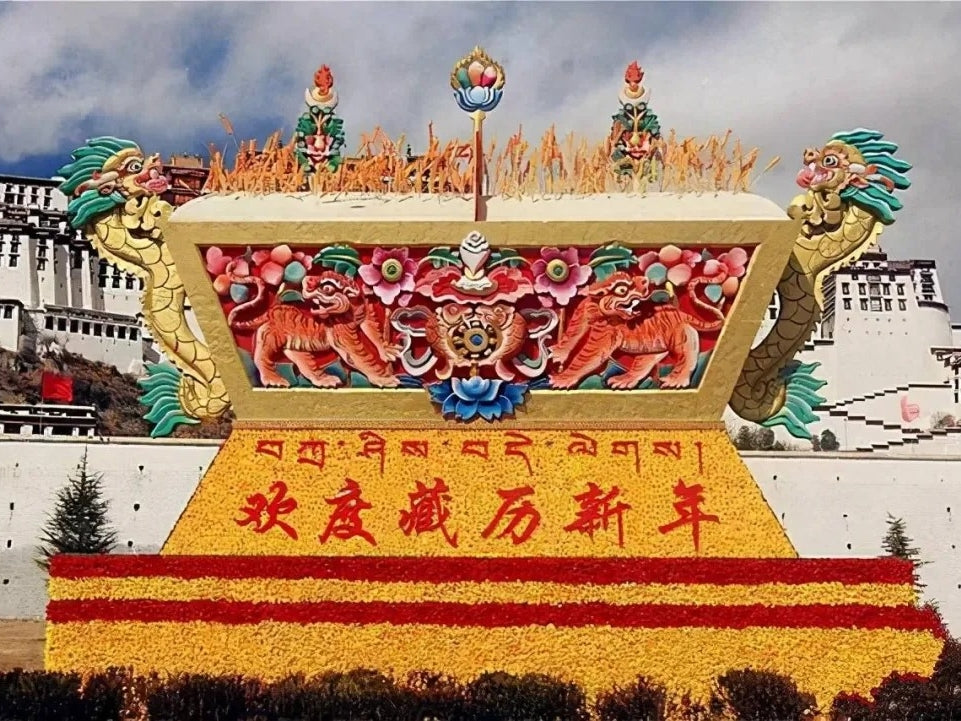Tashi Tagye—a phrase that appears in Tibetan decorative arts and ritual objects—signals good fortune, protection, and a courtly sense of dignity. Often translated loosely as an “auspicious emblem,” Tashi Tagye is less a single, fixed image than a family of motifs and visual languages that have been used for centuries across monasteries, palaces, and domestic objects. This article explores Tashi Tagye meaning, how the emblem functioned in historical court and temple settings, and the thoughtful ways contemporary designers bring this Tibetan auspicious symbol into jewelry and home objects today.

What “Tashi Tagye” evokes
At its core, Tashi Tagye represents auspiciousness—blessings for stability, prosperity, and spiritual well-being. In practice it often appears as a composed emblem combining one or more classical symbols (lotus, victory banner, endless knot, treasure vase) arranged with symmetry and visual clarity. Unlike a strictly iconographic deity image, Tashi Tagye reads as an emblem of good order and protection: something to be displayed where one wishes to invite blessing rather than to perform formal worship.

Historical use: courts, temples, and visible authority
Historically, auspicious emblems like Tashi Tagye were prominent in settings that combined political power and religious legitimacy:
-
Royal courts and palaces. Emblems were woven into banners, robes, and architectural ornament to visually express the ruler’s authority and the court’s auspicious mandate. A carefully arranged Tashi Tagye motif signaled legitimacy, cosmic order, and the ruler’s role as protector of the realm.
-
Temples and monastic halls. In monasteries, auspicious emblems appear on altarpieces, silk brocades, and ritual textiles. Here they operate as visual prayer—reminding observers of the ethical and spiritual ideals that sustain community life.
-
Ceremonial objects. Official seals, offering vessels, and festival standards often incorporated Tashi Tagye elements, reinforcing the link between ritual practice and social harmony.
Across these contexts, the emblem’s clarity and balance were as important as any single symbol it contains. Symmetry, repetition, and high-quality materials reinforced the emblem’s power to reassure and to mark a place as sacred or sanctioned.

Modern appearances: jewelry, textiles, and home objects
Contemporary artisans and designers respect Tashi Tagye’s symbolic weight while adapting it for modern taste and usage. Several patterns emerge:
-
Jewelry: Designers translate the emblem into pendants, cufflinks, and brooches that favor minimal compositions—an endless knot layered over a disc, or a stylized lotus inset with turquoise. Metals often used include sterling silver and brass; enamel and hand-painting are sometimes applied to evoke traditional color stories. Search terms like Tashi Tagye pendant or Tibetan auspicious symbol jewelry are increasingly common among buyers seeking meaning-driven accessories.
-
Textiles & home objects: Tashi Tagye motifs appear in throw pillows, wall hangings, and table runners—usually embroidered or block-printed. Designers mindful of provenance source fabrics and motifs from Himalayan workshops, or commission local artisan cooperatives to maintain craft legacies.
-
Ceramics & small altarpieces: Modern gawu shrine boxes or small decorative plates may bear simplified auspicious emblems, suitable for diaspora homes that want a respectful touch rather than a full ritual setup.
A key goal for contemporary makers is to balance symbolism with subtlety: keep the emblem recognizable to those who know it, yet wearable and approachable for everyday life.
How to wear and display Tashi Tagye respectfully
Tashi Tagye is an emblem of blessing, not mere ornament. A few practical guidelines help ensure respectfulness:
-
Context matters. If gifting a Tashi Tagye pendant, include a brief note explaining the symbol’s intent—auspice, protection, or blessing—so the recipient understands its meaning.
-
Placement and care. Treat consecrated or hand-painted pieces with basic reverence: avoid placing them on the floor, keep painted faces away from direct sunlight and moisture, and store silvers in soft cloths to prevent tarnish.
-
Avoid trivialization. Use the emblem thoughtfully—prefer smaller, subtle designs over oversized novelty items that reduce a sacred visual language to costume.
-
Learn a simple dedication. Before wearing or gifting the emblem, offer a short intention—two or three quiet sentences—for the wearer’s well-being. That small ritual connects object and person in a meaningful way.
Design notes for collectors and makers
For collectors interested in provenance, look for makers who can speak to materials, workshop practices, and whether the piece was created with cultural consultation. For designers adapting Tashi Tagye, the responsibilities are:
-
Preserve essential proportions and balance of the emblem.
-
Use authentic techniques where possible (hand-embroidery, lost-wax casting, enamel).
-
Credit artisans and, where feasible, work with maker cooperatives to ensure fair compensation.
Tashi Tagye is a quiet powerhouse in Tibetan visual culture: less an icon to worship than a visual promise of good order and blessing. When worn or displayed with understanding and respect, it functions as a bridge—connecting contemporary life to long-standing aesthetic and ethical traditions. Whether as a small pendant at the throat or an embroidered emblem on a living-room cushion, Tashi Tagye keeps an ancient wish alive: that life be ordered, protected, and suffused with auspicious possibility.




